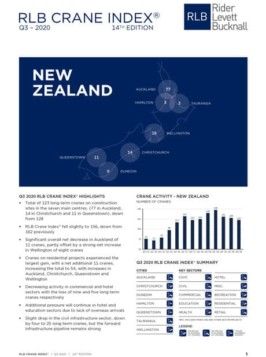According to today’s release of the Q3 2020 RLB Crane Index®, there are currently 123 construction cranes working on key projects across New Zealand, marking a relatively small 3.9% decline in overall crane numbers in the main centres since the outbreak of COVID-19.
Rider Levett Bucknall (RLB) Director Chris Haines said, ‘To date, the uncertainties surrounding the COVID-19 pandemic have not impacted the New Zealand construction industry quite as we had expected back in April, with only a small decline in crane numbers recorded since our last index.’
Cranes forced to stop during lockdown now back on projects
He added, ‘Whilst cranes on the majority of construction sites across the country were forced to stop during the Stage 4 lockdown, they are back working on projects, though many of these were committed prior to the outbreak and lockdown of March and April. The real impact of a decline in forward workload and subsequent long-term cranes is more likely to be felt in 2021.’
Wellington at a record high while Auckland records largest decline
According to RLB, different centres are currently performing at different speeds. Wellington is at record crane numbers with a net increase of 8 cranes since March, which could be attributed to the strength and consistency in government related work across many different sectors including commercial and civil infrastructure.
Chris continued, ‘In contrast, Auckland continues to drop from a Q1 2019 high with the largest decline recorded of 12.5% and a net reduction of 11 cranes. Currently, Hawkins, Fletcher’s and Naylor Constructions only have one tower crane each in Auckland, the lowest numbers we have seen from them since 2014.’
‘We have also seen a notable shift in the proportion of long-term cranes from the Auckland CBD into the suburbs, and in and around the key transport nodes,’ he said.
Residential sector sees biggest increase
According to the RLB Crane Index®, the residential sector experienced the largest increase, recording a net growth of 11 new long-term cranes, increasing the total to 54 cranes. Increases were seen in Auckland, Christchurch, Queenstown and Wellington. Auckland currently has 80% of all residential cranes across the main centres.’
Whilst Auckland recorded a net increase of five residential cranes, there is a clear two-speed market. Those involved in infrastructure and residential construction including aged care remain buoyant, but those outside these sectors are competing hard for a limited pipeline of new projects.
Concerns for vertical construction sector in the Upper North Island
Chris noted, ‘Serious concerns in the vertical construction sector in the Upper North Island exist due to the simultaneous drop-off in commercial, retail, hotels. tertiary education and civic sector projects. The vertical construction sector for new buildings and fitout work support significant small and medium sized businesses across multiple contractors, subtrades and suppliers, who may be seriously impacted.’
Government support higher in horizontal infrastructure sector
‘However, government support for ‘shovel ready’ projects remains far higher in the horizontal infrastructure sector which is focused on much fewer in-ground type trades and a very focused part of the market. Many projects recommended by Crown Infrastructure Partners remain in a holding pattern and dependant on whether the government chooses to support them from the remaining unallocated COVID support package,’ he said.
The RLB Crane lndex® fell by 3.9% from the 128 crane numbers recorded in Q1 2020. This decrease was the result of New Zealand’s total cranes decreasing by 5, to 123. These include 77 in Auckland, 15 in Wellington,14 in Christchurch, 11 in Queenstown, 3 in Hamilton and 3 in Tauranga.
Whilst Auckland dropped 11 cranes to 77 in this edition, it continues to contribute 63% of all cranes in the main centres across the country.
Decrease in building activity but promising growth in health sector
This drop in crane numbers is reflected in the decrease of building work put in place for the twelve months to June 2020. Auckland’s building activity decreased by 2.8%, dropping by $0.3b to a total of $9.85b. Despite the net increase of five new residential cranes, the total residential building activity decreased by 5.2%. In contrast, non-residential cranes decreased by 16, despite a small 1.6% increase in the non-residential building activity.
The decrease in overall building activity is mirrored in a fall in project consents, with Auckland’s total building consents dropping by 7.4% for the twelve months to June 2020. Despite the fall, there has been promising growth in the health sector, which experienced a 35.1% increase in building consents for the twelve months to June 2020. All the DHB’s in the Auckland region have significant projects commencing in 2021.
Metro Sports project the largest single crane count in New Zealand
Wellington has experienced a significant increase in crane numbers, with the region increasing by a net 8 cranes up to a record 15, a rise of 114%. Despite the country recording a fall in the civil sector, Wellington recorded a significant increase of four new civil cranes.
Christchurch also experienced a net increase of two cranes with four cranes now on the Metro Sports project. This is now the largest single crane count in the country.
Hotel and education sectors remain dependant on ‘trans-Tasman bubble’
According to RLB, there has been decreasing crane activity in the commercial and hotel sectors with the loss of nine and five long-term cranes respectively, and additional pressure will continue in hotel and education sectors due to lack of overseas arrivals. These sectors remain dependant on the success of the ‘trans-Tasman bubble’ and whether international students will be welcomed into NZ in 2021.
Chris added, ‘There was a slight drop in the civil infrastructure sector, down by four to 25 long-term cranes, but the forward infrastructure pipeline remains strong with government ‘shovel ready’ funding further supporting the sector,’ he said.
Building consents steady
Total building consents have remained steady for the twelve months to June 2020. Wellington and the South Island’s building consents increased significantly by 22% and 17% respectively.
Work put in place for the twelve months to June 2020 was up in Wellington (1.6%) and the South Island (3.6%), with the country as a whole dropping by 2.5%. Auckland’s consents were down 6.9% and work put in place down by 2.8% from the record highs seen in the previous twelve months.
2021 the year to watch
Chris concluded, ‘The recent partial Level 3 Auckland lockdown in August did not significantly impact construction sites as it did in April, with contractors now well set up to deal with H&S protocols on site.’
‘There is some uncertainty in the short term due to the election and the wait for a new government. 2021 is the year to watch, and the new government’s spending priorities to tackle the COVID-19 recession impacts,’ he said.
According to today’s release of the Q3 2020 RLB Crane Index®, there are currently 123 construction cranes working on key projects across New Zealand, marking a relatively small 3.9% decline in overall crane numbers in the main centres since the outbreak of COVID-19.
FURTHER INFORMATION:



